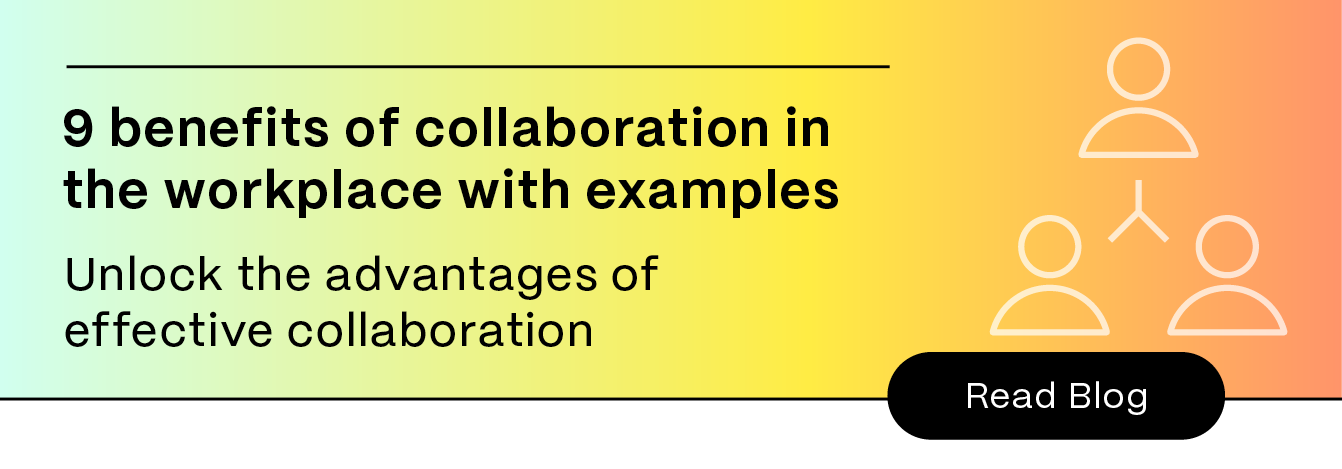
Blog
What is work management? An introductory guide

Navigating today's flexible work environment requires seamless collaboration and communication. Work management processes and solutions make this possible by centralizing information, aligning workflows, and providing a clear overview of projects and tasks.
This guide outlines the benefits and challenges of work management, revealing how technology can help transform your organization's operational efficiency.
What is work management?
Work management is the systematic approach to planning, executing, monitoring, and optimizing work processes within an organization. It encompasses a wide range of strategies and technology tools to help teams allocate tasks and resources, track project progress, and achieve business objectives. Work management aims to improve productivity, reduce inefficiencies, and ensure projects are completed within the desired timeframe and budget.
Core elements of work management
A successful work management process is built on combining essential practices with supporting technology.
Planning and organization
Planning involves setting goals, devising strategies, and gathering resources. Organizing includes allocating tasks and coordinating team efforts. Together, it minimizes chaos, improves efficiency, and drives better results through clear direction and structure.
Work management software is a powerful tool that can streamline the planning phase with features like:
- Resource allocation: Software optimizes utilization and prevents gridlocks by identifying needed resources (i.e., people, equipment, deliverables, and budget).
- Timeline creation: Visualizing project timelines through Gantt charts or Kanban boards helps in scheduling tasks and identifying potential conflicts.
- Teamwork tools: Real-time collaboration features enable team members to contribute to the planning process, share ideas, and provide feedback.
Task allocation
Task allocation involves strategically assigning work to team members based on their skills, workload, and priority. This practice ensures optimal resource utilization and efficient workflows.
Custom artificial intelligence (AI) workflow automation can significantly enhance this process. By defining clear task criteria and employee skill sets within the software, the system can suggest the right candidates for each deliverable. Additionally, automation can handle routine task assignments, freeing you up to focus on more complex project decisions.
Monitoring and tracking
Work management software solutions allow you to closely observe progress and capture continuous data on performance. This information can be used to identify barriers and make adjustments in real time. Methods for monitoring and tracking include:
- Progress reports: Regular updates on task completion, milestones achieved, and overall project status.
- Performance metrics: Key indicators like time spent, quality, and output to assess efficiency.
- Check-ins and status meetings: Regular touchpoints with team members to discuss progress, challenges, and next steps.
Collaboration and communication
Effective communication and collaboration help foster a shared understanding of goals, facilitate problem-solving, and ensure everyone is aligned toward a common vision. By working together, teams can generate innovative ideas and enhance overall productivity.
Dedicated collaboration spaces are essential for fostering this open environment. These digital platforms provide a central hub for your team to share information, discuss projects, and collaborate on tasks. Tools like secure file sharing, real-time document editing, and version control enable seamless teamwork and improve efficiency.
Related Read:9 benefits of collaboration in the workplace with examples

What are the steps in work management?
Now that you have a better understanding of what work management is, let’s dive into the five key steps your process should follow.
Step 1: Set goals and KPIs
The first step in a work management process is establishing clear and measurable goals. These targets should align with your broader organizational objectives and provide a clear direction for the project.
KPIs (key performance indicators) offer quantifiable metrics to track progress toward meeting your goals, identify areas for improvement, and measure overall project success. Through defining specific, measurable, achievable, relevant, and time-bound (SMART) goals, your team can better focus their efforts and work in lockstep.
Related Read: 10 productivity factors affecting the modern workplace
Step 2: Develop a plan
Once clear goals and KPIs are established, the next step is to create a detailed plan outlining the steps necessary to achieve those objectives. A well-structured plan provides a roadmap for the project, ensuring that everyone understands their roles and responsibilities.
- Identify tasks: Break down overarching goals into smaller, manageable tasks.
- Allocate resources: Determine the people, deliverables, and budget required for each task.
- Create timelines: Establish deadlines and milestones to track progress.
- Assess risks: Identify potential challenges and develop contingency plans.
- Centralize communication: Define how and where information will be shared.
Step 3: Schedule work
With a plan in place, it’s time to schedule the work. This step involves assigning specific deliverables to team members based on their skills and availability. Effective scheduling considers task dependencies, resource constraints, and deadlines. Tools like Gantt charts and project management software are helpful in distributing work evenly, preventing bottlenecks, and maximizing productivity.
Step 4: Execute the work
The execution phase is where team members carry out the assigned tasks according to the plan and schedule. By adequately managing this stage, you can ensure tasks are completed on time, within budget, and to the desired quality standards. This requires:
- Clear communication: Ensuring all team members understand their roles and responsibilities.
- Collaboration: Fostering teamwork and knowledge sharing.
- Oversight: Monitoring progress and providing support as needed.
- Flexibility: Being prepared to adapt to changes or unexpected challenges.
Step 4. Track progress
Continuous monitoring of progress is essential to ensure the project stays on track and meets its objectives. Regular updates and status reports can proactively identify potential risks and take corrective actions to ensure project success. This step involves actively:
- Measuring performance: Tracking KPIs and using data throughout to assess progress against goals.
- Identifying deviations: Comparing actual performance to the planned timeline and budget.
- Making adjustments: Modifying the plan or allocating resources as needed to address challenges.
Step 5: Review and evaluate
The final step in the work management process involves a comprehensive recap of the project. A thorough evaluation helps you identify areas for improvement, optimize future projects, and enhance overall efficiency. This includes:
- Benchmarking success: Comparing actual results to the original goals and KPIs.
- Discovering lessons learned: Analyzing successes and failures to gain valuable insights.
- Gathering feedback: Collecting input from team members and stakeholders.
- Implementing improvements: Making changes to processes or procedures based on the evaluation.
Benefits of effective work management
While there are many benefits to using robust work management processes, here are a few of the most common gains.
Increased productivity
Effective work management significantly boosts productivity by streamlining operations and optimizing resource allocation. When teams have clear goals, defined roles, and efficient processes, they can focus on high-impact tasks rather than waste time on unproductive activities.
According to Forbes, 64% of business owners believe that AI will improve business productivity, and 42% believe it will streamline job processes. Using work management software empowers teams to deliver more in less time because it helps eliminate confusion, reduce errors, and improve collaboration.
Better collaboration
A well-structured work management process fosters a collaborative environment where team members can seamlessly share ideas, knowledge, and resources. By providing a centralized platform for communication and task management, work management tools break down silos and encourage cross-functional collaboration.
A Tech.Co report found nearly half (46%) of leaders believe collaboration technology will highly affect business performance in 2024. When teams work together cohesively, they can identify and solve problems more efficiently — leading to increased innovation and improved decision making.

Reduced stress and burnout
A clear structure, defined roles, and achievable goals provide a sense of control and direction, alleviating the pressure and uncertainty that often leads to burnout. A study by the American Psychological Association found that 77% of workers have recently experienced work-related stress. This stress resulted in 57% experiencing negative impacts associated with burnout like lower productivity.
To help employees maintain a healthy work-life balance, employers can implement strategies such as:
- Flexible work arrangements: Offering options like remote work, flexible hours, or compressed workweeks.
- Clear expectations: Setting clear goals and priorities to reduce ambiguity and overload.
- Workload management: Ensuring workloads are reasonable and manageable.
- Support systems: Providing access to mental health resources, employee assistance programs, and wellness initiatives.
- Time off: Encouraging employees to take vacations and breaks.
Solve common challenges with a better work management process
An enhanced work management process is key to overcoming common business hurdles. This includes:
Siloed teams
Siloed teams, where departments or individuals work independently without effective communication, can lead to misalignment, inefficiencies, and poor outcomes. When information is not shared across teams, there's a higher risk of duplicated efforts, missed deadlines, and suboptimal decision-making.
Work management processes can help break down these silos by:
- Centralizing information: Providing a shared space for teams to collaborate and access information.
- Improving communication: Facilitating open communication and knowledge sharing through features like messaging and file sharing.
- Increasing cross-functional collaboration: Encouraging teamwork and cooperation across departments.
Confusion around roles and responsibilities
When roles and responsibilities are unclear, it can lead to confusion, delays, and ultimately, project failure. Without a distinct understanding of who is responsible for what, this can result in frustration and a decline in overall productivity.
Work management systems help clarify roles and responsibilities by:
- Assigning tasks: Defining who is responsible for each task or project component.
- Setting deadlines: Establishing clear expectations and timelines for task completion.
- Using automation: Automating routine tasks and notifications to reduce manual effort and potential errors.
- Providing visibility: Allowing team members to see who is working on what and when.
Restricted resources
Limited financial, human, or technological resources can create a challenging environment for teams, impacting their ability to deliver high-quality results. A McKinsey study found that two in five leaders cited insufficient resources as their biggest challenge to increasing organizational efficiency. For example:
- Budget constraints force teams to prioritize projects, potentially delaying or canceling important initiatives. This can lead to missed opportunities and reduced productivity.
- Insufficient personnel can overload existing employees, leading to burnout, decreased morale, and compromised quality of work.
- Skill gaps within the team can slow down project progress and require additional training or outsourcing, which can be costly and time-consuming.
- Limited or outdated software and tools can impede collaboration, communication, and overall efficiency, increasing the risk of errors.
Resistance to change
Without widespread acceptance and adoption, a work management system’s potential benefits will remain unrealized.
Resistance often stems from fear of the unknown, concerns about job security, or a lack of understanding of the benefits. To overcome this, organizations must invest in change management strategies, such as clear communication, training, and employee involvement in implementation.
Fostering a culture of open communication and providing adequate support can increase user adoption and maximize the return on investment in your work management system.
Supercharge your team’s management of work this year and beyond
Work management processes help to establish clear goals, develop strategic project plans, allocate tasks efficiently, and measure progress diligently. As a result, your team will reduce stress, increase productivity, and foster teamwork to achieve operational success.
However, overcoming common challenges like siloed teams, unclear roles, and resource constraints requires the right tools. A centralized work management platform can enhance communication, task management, and collaboration, empowering teams to work more efficiently and effectively.
Related Resources

Blog